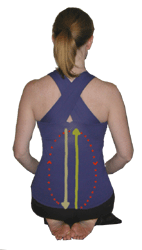Back bends are naturally more energetic than forward bends; forward bends are naturally more calming than back bends. We can practice the simple orbiting of energy in any asana, but when we are in back bends, it feels more natural to pause only at the top of the inhalation, and bring awareness to the ajna chakra. When we are in forward bends, it feels more natural to hold the breath only at the end of the exhalation, and bring our awareness to the muladhara chakras.
When you come into back bends like the Seal, Sphinx, or Saddle poses, orbit the energy as discussed above, but only hold the breath at the end of the inhalation. Bring awareness up to the ajna. Pause for a few seconds and then complete the orbit. Do this for approximately half of the time you are holding the pose. For the second half, simply release and follow the breath’s natural rhythm, or come to awareness of the predominant sensation in your body.
When you come into forward bends like the Butterfly, Dragonfly, or Snail poses, again orbit the energy, but this time, hold the breath only at the end of the exhalation. Bring awareness down to the muladhara. Engage your Chi bridge there. [1] Pause for a few seconds, and then complete the orbit.
In any other postures where you are in neither a forward bend nor a back bend, you can continue with holding the breath at the end of both inhalation and exhalation.
 A Simple Variation
A Simple Variation
Now that you have mastered a basic orbit, you may choose to add the side channels. Here we draw the energy down, as before, on the inhalation, but as we hold the breath for a couple of seconds, we send the energy up the left side of the torso, through the heart space, and down the right side, back to the base of the spine. We just hold at the end of the inhalation; there is no retention at the end of the exhalation. On the next cycle, circle the energy up the right side, and down the left side, while you retain the breath. Cycling the energy through the left and right sides of the body stimulates and balances the flow of energy through the ida and pingala nadis.
In all these variations you may wish to add the hamsa or so’ham breaths.
There is a yang variation to the orbiting breath: breathe very deeply and hold on full lungs – this is energizing. In a yin variation, breathe much more quietly, shallowly, and hold only on empty lungs – this is calming.
(Next: The Microcosmic Orbit )
